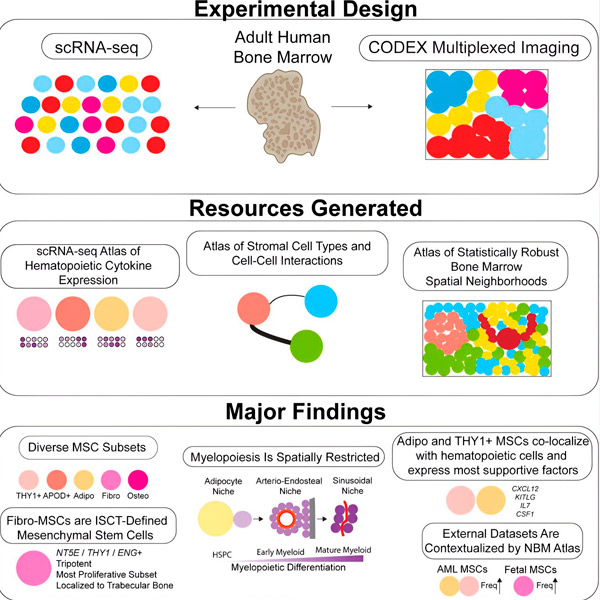New publications
A biomolecular atlas of bone marrow provides a unique insight into the process of hematopoiesis
Last reviewed: 02.07.2025

All iLive content is medically reviewed or fact checked to ensure as much factual accuracy as possible.
We have strict sourcing guidelines and only link to reputable media sites, academic research institutions and, whenever possible, medically peer reviewed studies. Note that the numbers in parentheses ([1], [2], etc.) are clickable links to these studies.
If you feel that any of our content is inaccurate, out-of-date, or otherwise questionable, please select it and press Ctrl + Enter.

Researchers at Children's Hospital of Philadelphia (CHOP) and the Perelman School of Medicine at the University of Pennsylvania have created a powerful new bone marrow atlas that will provide the public with a first-of-its-kind visual passport to the spectrum of healthy and diseased hematopoiesis. The results are published in the journal Cell.
“For the first time, we will have a comprehensive framework to view the complete gene expression and spatial organization of bone marrow cells,” said senior study author Kai Tan, PhD, professor in the Department of Pediatrics and an investigator in the Center for Childhood Cancer Research at CHOP. “While our paper is fundamental, we envision that the atlas will be used to develop new diagnostic tests, identify new targets for CAR-T therapy and other therapeutic approaches, and discover spatial biomarkers of disease.”
While the initiative was led by CHOP and Penn, the research is also part of a larger project called the Human BioMolecular Atlas Program (HuBMAP). The HuBMAP consortium is made up of 42 different research groups from universities in 14 states and four countries. Researchers are collaborating to create the next generation of molecular analysis technologies and computational tools that will create basic tissue maps and atlases of the functions and relationships between cells in the human body.
“Research of this magnitude is only possible through a monumental team effort,” said Showik Bandyopadhyay, PhD, lead author of the study and a physician-scientist in training in Tan’s lab. “Through collaborations across multiple institutions and research consortia, we were able to gain fundamental insights into the microscopic building blocks of the human body.”
Scientists have long theorized that although most bone marrow is made up of blood cells, a small percentage of non-blood cells may play an important role in childhood and adult bone marrow diseases such as leukemia, myeloproliferative disorders, or bone marrow failure syndromes. However, until this study, such studies had been hampered by technical challenges associated with the rarity and fragility of these cells.
This paper is the first to overcome these limitations and comprehensively profile adult human bone marrow using single-cell RNA sequencing. This technique allows for the capture of complete gene profiles of tens of thousands of individual cells, revealing the full composition of the cell types that make up an organ.

Source: Cell (2024). DOI: 10.1016/j.cell.2024.04.013
In the study, the scientists focused on bone marrow, which regulates important processes in blood cell development and immunity. They identified at least nine subtypes of non-hematopoietic cells, including stromal cells, bone cells, and endothelial (blood) cells, at least three of which had not been previously described, that produced important support factors. The researchers created an encyclopedia of these rare non-blood cells that produce factors thought to be important for human hematopoiesis, which will help better understand which cellular communication should be focused on in future studies.
Their results highlight the increasingly important role of technology in today’s biomolecular research. The authors created a spatial atlas of bone marrow, including some 800,000 cells, using a sophisticated new technique called CODEX combined with machine learning. This approach, along with careful manual annotation of thousands of cells and structures, allowed them to determine that healthy bone marrow has a very distinct spatial organization, and that fat cells are more closely related to hematopoietic cells than previously thought.
“We’re just beginning to understand what’s possible,” Tan said. “Future studies can build on our work, accelerating bone marrow research with the hope that one day these digital pathways will lead to medical breakthroughs in the treatment of acute leukemia and other bone marrow diseases.”
Ling Qing, PhD, another senior author of the study and a professor of orthopedic surgery at the Perelman School of Medicine, agrees and believes the study will yield long-term results.
"When applied to samples from leukemia patients, these techniques reveal an expansion of mesenchymal cells, a type of rare non-blood cell, at the site of cancer cells in the bone marrow," Qing said. "This points to a possible new direction for future disease treatment."
